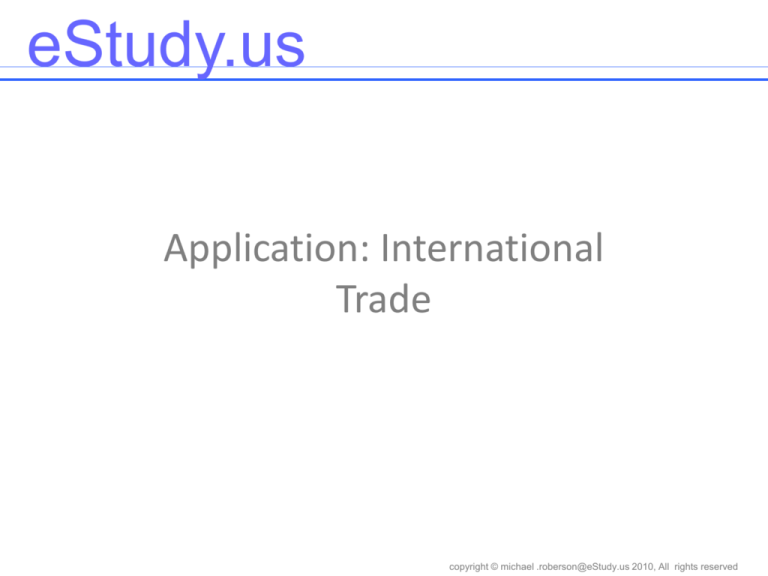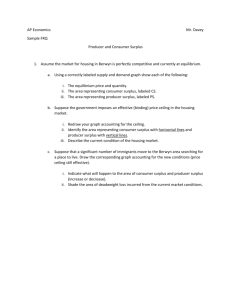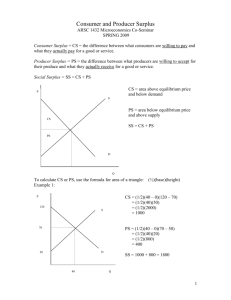
eStudy.us
Application: International
Trade
copyright © michael .roberson@eStudy.us 2010, All rights reserved
eStudy.us
Determinants of Trade
Equilibrium without trade
– Domestic buyers and sellers
– Equilibrium price and quantity
• Determined on the domestic market
– Total benefits
• Consumer surplus
• Producer surplus
copyright © michael .roberson@eStudy.us 2010, All rights reserved
eStudy.us
Equilibrium without international trade
Price of
corn
Domestic
Supply
Consumer
surplus
Equilibrium
price
Producer
surplus
Domestic
Demand
0
Equilibrium
quantity
Quantity
of corn
When an economy cannot trade in world markets, the price adjusts to balance domestic
supply and demand. This figure shows consumer and producer surplus in an equilibrium
without international trade for the textile market in the imaginary country of Isoland.
copyright © michael .roberson@eStudy.us 2010, All rights reserved
eStudy.us
Questions of Trade
Allow for international trade
– What happens to price and quantity sold in the
domestic market?
– Who will gain from free trade; who will lose, and will
the gains exceed the losses?
– Should a tariff be part of the new trade policy?
copyright © michael .roberson@eStudy.us 2010, All rights reserved
eStudy.us World Price and Comparative Advantage
• World price is the price that prevails in the world market
for a good (consistent with comparative advantage)
• Domestic price is opportunity cost of the good
• Comparing domestic price with world price determines
who has the comparative advantage
– If domestic price < world price
• Country has a comparative advantage
• and will export the good
– If domestic price > world price
• Import the good
• World – comparative advantage
copyright © michael .roberson@eStudy.us 2010, All rights reserved
International trade in an
exporting country
eStudy.us
Price of
corn
U.S.A
Exports
Domestic
Supply
A
Price
after
trade
B
Price
before
trade
World
Price
D
C
Domestic
Demand
0
Domestic Domestic Domestic
Quantity Quantity Quantity
Demanded
Supplied
Consumer Surplus
Producer Surplus
Total Surplus
Once trade is allowed, the domestic price rises to
equal the world price. The supply curve shows
the quantity of textiles produced domestically,
and the demand curve shows the quantity
consumed domestically. Exports from Isoland
equal the difference between the domestic
quantity supplied and the domestic quantity
demanded at the world price. Sellers are better
off (producer surplus rises from C to B + C + D),
and buyers are worse off (consumer surplus falls
from A + B to A). Total surplus rises by an
amount equal to area D, indicating that trade
raises the economic well-being of the country as
a whole.
Quantity of corn
Before trade
After trade
Change
A+B
C
A+B+C
A
B+C+D
A+B+C+D
-B
+(B+D)
+D
The area D shows
the increase in total
surplus and
represents the
gains from trade
copyright © michael .roberson@eStudy.us 2010, All rights reserved
eStudy.us
International trade in an
exporting country
• The gains and losses of an exporting country
• If domestic equilibrium price before trade is
below world price
• Once trade is allowed
•
•
•
•
Domestic price rises to world price
Domestic quantity supplied > domestic quantity demanded
The difference is exports
Domestic Winner: Producers, sell more output and the higher
world price
• Domestic Loser: Consumers, purchase less product and the
higher world price
• Net Gains from trade: winners exceed value that of losers
copyright © michael .roberson@eStudy.us 2010, All rights reserved
International trade in an
importing country
eStudy.us
Price of
wheat
U.S.A
Domestic
Supply
A
Price
before
trade
B
Price
after
trade
D
World
Price
C
Imports
0
Domestic
Demand
Domestic Domestic Domestic
Quantity Quantity Quantity
Supplied
Demanded
Consumer Surplus
Producer Surplus
Total Surplus
Once trade is allowed, the domestic price falls to
equal the world price. The supply curve shows
the amount produced domestically, and the
demand curve shows the amount consumed
domestically. Imports equal the difference
between the domestic quantity demanded and
the domestic quantity supplied at the world price.
Buyers are better off (consumer surplus rises
from A to A + B + D), and sellers are worse off
(producer surplus falls from B + C to C). Total
surplus rises by an amount equal to area D,
indicating that trade raises the economic wellbeing of the country as a whole
Quantity of wheat
Before trade
After trade
Change
A
B+C
A+B+C
A+B+D
C
A+B+C+D
+(B+D)
-B
+D
The area D shows
the increase in total
surplus and
represents the
gains from trade
copyright © michael .roberson@eStudy.us 2010, All rights reserved
eStudy.us
International trade in an
exporting country
• The gains and losses of an importing country
• If domestic equilibrium price before trade is
above world price
• Once trade is allowed
•
•
•
•
Domestic price lowers to world price
Domestic quantity supplied < domestic quantity demanded
The difference is imports
Domestic Winner: Consumers, purchase more product at the
lower world price
• Domestic Loser: Producers, sell less product and the lower
world price
• Net Gains from trade: winners exceed value that of losers
copyright © michael .roberson@eStudy.us 2010, All rights reserved
eStudy.us
•
•
•
•
Other benefits of international trade
Increased variety of goods
Lower costs through economies of scale
Increased competition
Enhanced flow of ideas
copyright © michael .roberson@eStudy.us 2010, All rights reserved
eStudy.us
Trade Restrictions – Tariff
• Tariff – a tax on goods produced abroad and
sold domestically
• Free trade
– Domestic price = world price
• Tariff on imports
– Raises domestic price above world price by the
amount of the tariff
copyright © michael .roberson@eStudy.us 2010, All rights reserved
eStudy.us
Price of wheat
Effects of a tariff
U.S.A
Domestic
Supply
A
Tariff
B
Price with tariff
C
Price without
tariff
G
0
E
D
F
World
Price
Imports
with tariff
Q1S
Q2S
A tariff reduces the quantity of
imports and moves a market closer
to the equilibrium that would exist
without trade. Total surplus falls by
an amount equal to area D + F.
These two triangles represent the
deadweight loss from the tariff.
Domestic
Demand
Q2D Q1D
Quantity of wheat
Imports without tariff
Consumer Surplus
Producer Surplus
Government Revenue
Total Surplus
Before tariff
After tariff
Change
A+B+C+D+E+F
G
None
A+B+C+D+E+F+G
A+B
C+G
E
A+B+C+E+G
-(C+D+E+F)
+C
+E
-(D+F)
The area D + F
shows the fall in
total surplus and
represents the
deadweight loss of
the tariff
copyright © michael .roberson@eStudy.us 2010, All rights reserved
eStudy.us
The effects of a tariff
•
•
•
•
•
Price rises by the amount of the tariff
Domestic quantity demand decreases
Domestic quantity supply increases
Reduces the quantity of imports
Moves the domestic market closer to its
equilibrium without trade
• Domestic sellers are better off
• Domestic buyers are worse off
copyright © michael .roberson@eStudy.us 2010, All rights reserved
eStudy.us
The effects of a tariff
• Before the tariff
– Consumer surplus
– Producer surplus
– Government tax revenue is zero
• With a tariff
– Consumer surplus is now smaller
– Producer surplus is now bigger
– Government tax revenue increases
– Total surplus is now smaller
copyright © michael .roberson@eStudy.us 2010, All rights reserved
eStudy.us Arguments For Restricting Trade
• The jobs argument
– “Trade with other countries destroys domestic jobs”
– Free trade creates jobs at the same time that it
destroys them
• The national-security argument
– “The industry is vital for national security”
– When there are legitimate concerns over national
security
copyright © michael .roberson@eStudy.us 2010, All rights reserved
eStudy.us Arguments For Restricting Trade
• The infant-industry argument
– “New industries need temporary trade restriction to
help them get started”
– Difficult to implement in practice
– A “temporary” policy that is hard to remove
– Protection is not necessary for an infant industry to
grow
• The unfair-competition argument
– “Free trade is desirable only if all countries play by
the same rules”
– Increase in total surplus for the country
copyright © michael .roberson@eStudy.us 2010, All rights reserved
eStudy.us Arguments For Restricting Trade
• The protection-as-a-bargaining-chip argument
– “Trade restrictions can be useful when we bargain
with our trading partners”
– The threat may not work
copyright © michael .roberson@eStudy.us 2010, All rights reserved
eStudy.us
Trade agreements and the
World Trade Organization
• Unilateral approach to achieve free trade
– Remove trade restrictions on its own
– Great Britain - 19th century
– Chile and South Korea - recent years
copyright © michael .roberson@eStudy.us 2010, All rights reserved
eStudy.us
Trade agreements and the
World Trade Organization
• Multilateral approach to achieve free trade
– Reduce its trade restrictions while other countries
do the same
– Bargain with its trading partners in an attempt to
reduce trade restrictions around the world
– North American Free Trade Agreement (NAFTA)
• 1993 - lowered trade barriers among the United States,
Mexico, and Canada
– General Agreement on Tariffs and Trade (GATT)
• Continuing series of negotiations among many of the
world’s countries with the goal of promoting free trade
copyright © michael .roberson@eStudy.us 2010, All rights reserved
eStudy.us
Trade agreements and the
World Trade Organization
• GATT
– United States - helped to found GATT
• After World War II
• In response to the high tariffs imposed during the Great
Depression
– Successfully reduced the average tariff among
member countries from about 40% to 5%
– Enforced by the World Trade Organization (WTO)
– 151 countries; 97 % of world trade
copyright © michael .roberson@eStudy.us 2010, All rights reserved
eStudy.us
Trade agreements and the
World Trade Organization
• Advantage of the multilateral approach
– Potential to result in freer trade
• Reduce trade restrictions abroad and at home
– Political advantage
• Producers - fewer and better organized than consumers
• Greater political influence
copyright © michael .roberson@eStudy.us 2010, All rights reserved









